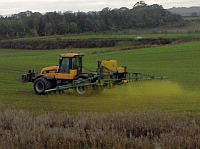Biological monitoring
of pesticide exposure
in residents near
to agricultural
land
 The
IOM pesticide
biomonitoring
project,
“Biological
monitoring of
pesticide
exposure in
residents near
to agricultural
land” ran from
2010 to 2015 and
investigated the
use of
pesticides and
their possible
health effects.
By studying
pesticide
exposure during
and outside the
spraying season
for residents
(both adults and
children) living
next to
agricultural
fields (both
farms and
orchards).
The
IOM pesticide
biomonitoring
project,
“Biological
monitoring of
pesticide
exposure in
residents near
to agricultural
land” ran from
2010 to 2015 and
investigated the
use of
pesticides and
their possible
health effects.
By studying
pesticide
exposure during
and outside the
spraying season
for residents
(both adults and
children) living
next to
agricultural
fields (both
farms and
orchards).
The research,
led by Dr Karen
Galea at IOM, in
collaboration
with the Health
and Safety
Laboratory (HSL)
and Glasgow
Caledonian
University (GCU)
was sponsored by
the Department
for Environment,
Food and Rural
Affairs (DEFRA).
Study results
showed that
exposure to
pesticides for
the residents
living close to
the sprayed
fields and
orchards was no
higher following
spraying events
than during
other days when
no spray
activities took
place.
Background
levels of some
pesticides were
higher during
the spraying
season than
outside the
spraying season.
Overall, the
levels of
pesticide
exposure were
low and probably
mostly due to
dietary intakes.
The research
provides
evidence that
the exposure
assessment
carried out as
part of the
approval process
for pesticides
does not
underestimate
the actual
exposure.
The Pesticide
Biomonitoring
Project website
is now closed.
The final
scientific
report for the
project
is available
from the DEFRA
website.
Further
information
about the
project can also
be obtained from
Dr Karen Galea at IOM,
email:
karen.galea@iom-world.org.
How was the Biological monitoring
project carried
out?
The use of pesticides
and their possible
health effects is
a subject that gives
rise to much public
concern and discussion.
There have been
reports of ill health
attributed to pesticide
exposure. In particular,
some people living
next to agricultural
land attribute health
problems, rightly
or wrongly, to
their exposure to
pesticides sprayed
on these fields.
There is currently
a lack of reliable
exposure information
for residents and
bystanders in the
UK.
In a previous study,
we showed that the
methods currently
used for assessing
pesticide exposure
for regulatory purposes
were appropriate
for farm workers. However,
the method appeared
to underestimate
the actual levels
for bystanders. No
measurements were
collected for residents.
Further measurements
will be made to
determine if current
tools and methods
are appropriate
for assessing exposure
amongst residents
living near fields.
Study aims and
objectives
Our study investigated pesticide
exposure during
and outside the
spraying season
for residents (both
adults and children)
living next to agricultural
fields (both farms
and orchards) and
assessed whether
the methods used
for regulatory risk
assessment are appropriate
for assessing exposure
amongst residents
living near fields.
We did this
by collecting urine
samples from residents
and comparing
the levels of pesticide
metabolites in the
urine of people
that have been exposed
to pesticides due
to spraying with
the level of residue
predicted from data
obtained from a
variety of sources.
The end result
should determine if
the current system
used to regulate
pesticide exposure
provides suitable
protection for those
people exposed.
Who is funded
and organised this
research?
In Great Britain
the use of pesticides
in agriculture,
horticulture, forestry,
food storage and
the home or garden
is regulated to
protect human health
and the environment.
The regulatory system
is administered
by the Department
for Environment,
Food and Rural Affairs
(DEFRA).
The Institute
of Occupational
Medicine (IOM),
in collaboration
with the Health
and Safety Laboratory
(HSL)
and Glasgow Caledonian
University (GCU)
were awarded funding
by DEFRA to help
investigate this
issue.
2015: Project findings
now reported!
The project team
are pleased to report
that the project
findings are now
available.
In summary, the
results showed that
the exposure to
pesticides for the
residents living
close to the sprayed
fields and orchards
was no higher following
spraying events
than during other
days when no spray
activities took
place. Background
levels of some pesticides
were higher during
the spraying season
than outside the
spraying season.
Overall, the levels
of pesticide exposure
were low and probably
mostly due to dietary
intakes.
This research provides
evidence that the
exposure assessment
carried out as part
of the approval
process for pesticides
does not underestimate
the actual exposure.
The final scientific
report for the project
is available from
the DEFRA website:
Click here to view
report